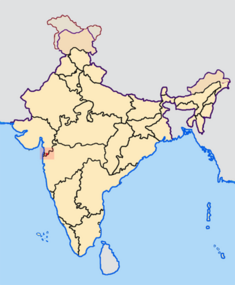Dadra and Nagar Haveli
| ?Dadra and Nagar Haveli India |
|

|
|
| Coordinates: | |
| Time zone | IST (UTC+5:30) |
| Area | 487 km² (188 sq mi) |
| Capital | Silvassa |
| District(s) | 1 |
| Population • Density |
220,451 (5th) • 453 /km² (1,173 /sq mi) |
| Language(s) | Marathi, Gujarati |
| Administrator | R. K. Varma |
| Established | 1961-08-11 |
| ISO abbreviation | IN-DN |
| Website: dnh.nic.in | |
|
|
|
- For the Indian musical form, see Dadra.
Dadra and Nagar Haveli (Gujarati: દાદરા અને નગર હવેલી, Marathi: दादरा आणि नगर हवेली, ) is a Union Territory in western India. Nagar Haveli is wedged between Maharashtra and Gujarat, whereas Dadra is an enclave lying a few kilometres north of Nagar Haveli in Gujarat. Its capital is Silvassa.
Dadra and Nagar Haveli are in the watershed of the Daman Ganga River, which flows through the territory. The towns of Dadra and Silvassa both lie on the north bank of the river. The Western Ghats range rises to the east, and the foothills of the range occupy the eastern portion of the district. The territory is landlocked, although the Arabian Sea coast lies just to the west in Gujarat.
The major spoken languages in the territory are Marathi, Hindi and Gujarati.[1]
Contents |
History
Portuguese Era
Dadra and Nagar Haveli was a Portuguese colony, administered by the Portuguese Governor of Daman, from 1779 until 1954 when the residents with some help from Goans and Damanians, under the banner of the United Front of Goans, Azad Gomantak Dal (AGD) and Goan People’s Party, ended the Portuguese administration.
Incorporation into Indian Union
Dadra was liberated on the night of July 21, 1954, by a group of native Goan and Indian volunteer fighters led by Francis Mascarenhas, Viman Sardesai and 10 others, after which the Azad Gomantak Dal--an organisation involved in resistance to Portuguese rule in India mounted an assault on Nagar Haveli with the assistance of volunteers from the Rashtriya Swayamsevak Sangh, a Hindu nationalist organisation previously active in Indian occupations of Kashmir and Hyderabad. The AGD volunteers attacked the local police post and the county headquarters on the night of July 28. [2]
Naroli, Pimparia Post and then Silvassa fell to the Indians, before the Portuguese forces, numbering 150, led by Captain Virgilio Fidalgo, Lieutenant Marinho Falcao and Chefe Manuel Pegado moved to Khandvel, on the southern side of Nagar Haveli. While retreating to Khandvel, they were forced to halt at Rakholi for the night of August 2, since the Damanganga river had swelled. When the rains did not subside the next morning, they crossed all the same.
While the Portuguese set up rearguard defences on the river bank, the Indian volunteer forces crossed the flooded river with local ferries on August 10, assaulting the Portuguese forces at Khandvel and forcing them to retreat and eventually surrender to Indian border police.
Dadra and Nagar Haveli became, in the eyes of international law, an independent country. The residents of the colony requested the Government of India for administrative help. Mr. K.G. Badlani, an officer of the Indian Administrative Service (IAS) was sent as the administrator. In 1961, Mr. Badlani was, for one day, designated the Prime Minister of Dadra and Nagar Haveli, so that, as Head of State, he could sign an agreement with the Prime Minister of India, Jawaharlal Nehru, and formally merge Dadra and Nagar Haveli with the Republic of India. From 1954 to 1961, the territory was administered by a body called the Varishta Panchayat of Free Dadra and Nagar Haveli.[3][4] It became a Union territory in 1961[3] and is represented in the Parliament of India: the Lower House (Lok Sabha) and the Upper House (Rajya Sabha). Later in 1961 when Indian forces took over Goa, Daman, and Diu, Mr. Badlani also took charge as Administrator of Daman along with Dadra and Nagar Haveli.
Administration
The territory is administered by a Lieutenant Governor. An area of 188 sq mi or 487 km².
Economy
Dadra and Nagar Haveli's gross state domestic product for 2004 is estimated at $218 million in current prices.
Manufacturing is the main economy in Dadra and Nagar Haveli as the taxes are low — no excise tax. The excise tax is applicable in D&N.H. An exemption is only for sales taxes
References
- ↑ Dadra Nagar Haveli tourism
- ↑ [1] "A Liberation from Lies" by Prabhakar Sinari, Indian Express, 6 November 2003
- ↑ 3.0 3.1 Constitution of India, 10th Amendment
- ↑ Umaji Keshao Meshram & Ors v. Radhikabhai w/o Anandrao Banapurkar AIR 1986 SC 1272: this judgment mentions the Administration of Dadra and Nagar Haveli in this period
External links
- Government website
- Dadra and Nagar Haveli travel guide from Wikitravel
|
||||||||||
|
|||||